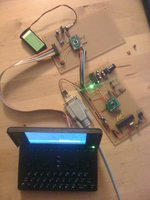Adafruit sells a ready-to-go
TXB0108 breakout board for 8 US dollars. The royal You might be interested in that. Also check the App note in the downloads tab. Consider it a TXB0106 with 2 spare parts.
I've made a test setup where a microcontroller on 1.8V acts as the Pandora gpio's that interface with 2 inputs (tactile buttons, 1 pulled up, 1 pulled down), 2 outputs (transistors + LED's), and the UART (generic 5.0V RS232-chip). This all works as expected. It might be the most elaborate and inefficient way to make an LED light up when you press a button, but I wanted to be able to abuse the TXB0106 in the most horrible of ways without it all ending in tears.
In the picture, only the RS232-part of the test-board is used to log in on the Pandora on the PC. That part can be used stand-alone. The microcontroller can also be used stand-alone running on 5V, communicating with and powered by an FTDI USB-cable.

I have readings on the voltmeter that don't make sense to me. I can't read the 'transitions' between states reliably. I can measure the pins being HIGH or LOW on both sides of the TXB0106 without problems. It all checks out, and there's nothing wrong with individual 'readings'. However, when I press a button
without removing the voltmeter from the pin, the pin 'switches' between 2.25V (LOW) and 2.7V (HIGH) on the 5V side, and between 0.8V and 1.0V on the 1.8V side. When I *do* remove the voltmeter and then measure again, it's back to either 0.0V and 1.8V (or 0.0V and 5.0V) what it should be. The same with outputs.
So as soon as I measure things, it influences the behavior of the TXB0106 and everything goes haywire. When I simply leave it alone and "just use it", everything's OK and hunky-dory and normal and awesome. I can live with that, but understanding it would be better.
I'm not sure what to do with that Output Enable (OE) pin on the TXB0106. When LOW, the rest of the pins are in "high-impedance mode", basically disabling them. It's pulled up to VCCA at the moment, but I think I'd want control over it by a microcontroller or button and have it LOW when it "boots up", pulling it HIGH when everything else is set up. When I attach the battery, I can see 1 LED light up for a short period when it shouldn't. That doesn't happen when OE is LOW during that time. So I'd want to power everything on with OE LOW, then pull it up after a few milliseconds.
If I understand correctly, the TXB0106 has internal 4K pull-up resistors on both sides. You have no control over that, so deal with it if you want to add your own. For inputs, I used 1K pull-down and pull-up on the 5V side, no internal pull-up setup on the microcontroller (read: Pandora). That worked for me. YMMV.


